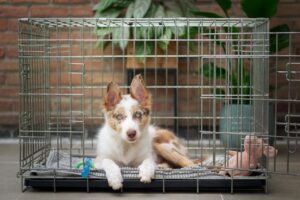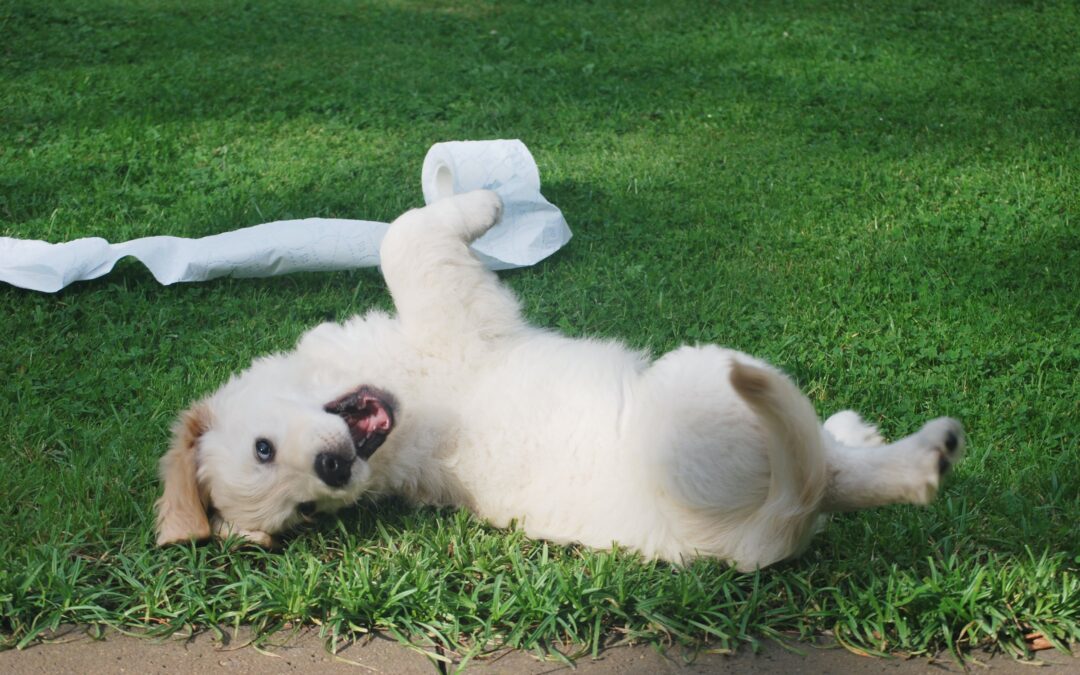Well, well, congratulations on acquiring your delightful new furry friend! Let me tell you, not everyone fully comprehends the sheer amount of effort it takes to handle some puppies during the initial six months, and trust me, that’s just the tip of the iceberg. Ah, the joys of potty training a puppy. It can feel like an insurmountable task, much like dealing with a tiny human newborn. These little bundle of joy demand undivided attention and, just like infants, are likely to jolt you awake in the early hours of the day. Follow along with us as we discuss the best steps to a house broken puppy.
Typically, by the time your furry pal reaches four to five months old, they should be well on their way to being fully housebroken thanks to the wonders of crate training. Of course, this timeline can differ depending on just how committed and determined you are in this endeavor. It’s essential to remember that it’s up to you to take charge and set the pace when it comes to house-training your furry friend. So don’t give up and keep pushing forward, because success is within your grasp!
You might be asking yourself, “How do I begin?” To begin with, acquire a crate, ideally one that has a divider so you can enlarge the living area for your furry friend as it gets bigger. Without the use of a crate, it’s incredibly challenging to train a puppy to behave in the house. The entire process of teaching a puppy to use the designated crate for its needs is crucial for successful housebreaking. The crate becomes their special place, their sanctuary, where they can be safely kept during the housebreaking process when you’re unable to keep a close eye on them.
Choose a crate that allows your canine companion to stretch out comfortably, stand up straight, and even twirl around. Avoid placing a small puppy in a crate that is too big for them. It’s best to provide just enough space as mentioned earlier. It’s a great idea to invest in a larger crate with an adjustable divider. This allows you to adapt the space as your puppy grows. If you notice your puppy using the crate as a restroom, you may need to decrease the available space. Sometimes, when the crate is too large compared to your puppy’s size, they may not mind soiling the back corner of the crate as it doesn’t affect them as much.
It’s important to make sure your adorable puppy spends a good amount of time in its crate during the initial months of being with you. There’s absolutely no need to feel guilty about this as it’s comparable to how babies are kept in cribs for their own safety. Just like a crib protects babies from potential harm, a crate provides the same level of care and protection for your precious furry friend.
Be proactive with your puppy. As a general guideline, your furry friend should be taken outside approximately 30 minutes after having a meal or a drink. So if you’re aware that they have recently eaten or had a lot of water, seize the opportunity and take them outside; don’t wait for them to have an accident indoors. Additionally, it is wise to bring them outside after an energetic play session indoors. Whether you’re playing tug-of-war, throwing a ball, or getting them riled up, it’s always a great idea to take the lead and bring them outside after these activities too.
 Using a specific phrase during the process of housebreaking your puppy is crucial for success. Right from the beginning, establish a keyword to be used when your puppy needs to relieve themselves outside. Many people find the phrase “go potty” to be effective. Whenever you notice your pup sniffing around in the grass during outdoor time, consistently repeat the key phrase “go potty”. Once your puppy does their business, promptly offer them praise (through words, physical affection, or even a treat). With time, your puppy will make the connection between the key phrase “go potty” and the act of going to the restroom, typically around one month into the housebreaking journey. Once this time period is over, if you notice your furry companion showing signs of needing to relieve themselves indoors (such as holding their tail high and sniffing around in circles), confidently remind them of the familiar question they’ve been hearing since day one: “Need to go potty?” They will instantly remember this specific phrase linked to going outside and eagerly make their way to the nearest door, confirming their urgent need to go out. This marks the initial milestone in the journey of successfully housebreaking your pup.
Using a specific phrase during the process of housebreaking your puppy is crucial for success. Right from the beginning, establish a keyword to be used when your puppy needs to relieve themselves outside. Many people find the phrase “go potty” to be effective. Whenever you notice your pup sniffing around in the grass during outdoor time, consistently repeat the key phrase “go potty”. Once your puppy does their business, promptly offer them praise (through words, physical affection, or even a treat). With time, your puppy will make the connection between the key phrase “go potty” and the act of going to the restroom, typically around one month into the housebreaking journey. Once this time period is over, if you notice your furry companion showing signs of needing to relieve themselves indoors (such as holding their tail high and sniffing around in circles), confidently remind them of the familiar question they’ve been hearing since day one: “Need to go potty?” They will instantly remember this specific phrase linked to going outside and eagerly make their way to the nearest door, confirming their urgent need to go out. This marks the initial milestone in the journey of successfully housebreaking your pup.
Empower your puppy to communicate their needs by utilizing a bell attached to a string. Fasten the bell at the height of your puppy’s chest on the doorknob. Whenever you bring your puppy outside, encourage them to ring the bell with their paw. Show them appreciation instantly and grant them access through the door. Consistently following this routine will teach your puppy the connection between ringing the bell and the door opening. As time goes on, your furry companion will come to understand that ringing the bell signifies their desire to go outside for a bathroom break, prompting the door to open.
The key to successfully housebreaking your puppy is having constant supervision. I cannot stress enough just how crucial it is to always be watching your furry friend. What does this mean exactly? It’s quite simple really; if your puppy is not in its crate, you or someone else in the household should always be keeping an eye on them. Until your little one is fully trained, there should never be a moment when they are left alone in a room. To put it in perspective, even if you’re downstairs with your pup and decide to take a quick shower for just a few minutes, make sure to secure them in their crate.
Once more, envision your furry friend as a little bundle of joy. Suppose you have a precious baby and you want to quickly hop into the shower or step out of the room to neatly arrange clothes. Would you ever consider leaving an innocent baby all alone in the living room? Of course not! Instead, you would gently place them in the safety of their crib. Similarly, remember that a crate is nothing more than a secure haven for babies.
When you are closely supervising your furry companion and notice them starting to relieve themselves indoors, let out a firm and assertive “No!” swiftly scoop them up and carry them outside. Place them gently in the yard and repeat the phrase “Go potty.” Once they have finished their business, shower them with praise and rewards, such as a kind word, gentle petting, or a tasty treat. Remember, it is essential to avoid any form of punishment. Resorting to methods like rubbing their nose in it, hitting them, or using a rolled-up newspaper has been proven to be ineffective. More importantly, it damages the loving connection between you and your pup. Just like it would be unreasonable to spank a one-year-old for using their diaper, physically punishing a puppy for bathroom accidents indoors is unjustified.
yard and repeat the phrase “Go potty.” Once they have finished their business, shower them with praise and rewards, such as a kind word, gentle petting, or a tasty treat. Remember, it is essential to avoid any form of punishment. Resorting to methods like rubbing their nose in it, hitting them, or using a rolled-up newspaper has been proven to be ineffective. More importantly, it damages the loving connection between you and your pup. Just like it would be unreasonable to spank a one-year-old for using their diaper, physically punishing a puppy for bathroom accidents indoors is unjustified.
Many individuals often wonder, “What if I didn’t witness him in the act but noticed he used the restroom inside the house?” It’s quite simple, refrain from taking any action. Yes, you heard it right, don’t take any action at all. Consider it as a personal setback, clean up the mess, and continue moving forward. Once again, avoid punishing the puppy. Remember, it’s you who didn’t succeed, not the puppy. You disregarded the most important rule in housebreaking: you didn’t provide adequate supervision. This point is so crucial that it deserves to be emphasized once more: if you don’t physically catch your dog in the act, accept it as a loss on your part and continue with your efforts. Make it your aim to catch him every single time. Every instance your pup goes inside the house without being caught, it prolongs the housebreaking process by a few more days. Therefore, if he goes inside the house multiple times per day without being caught, it significantly extends the time required for successful housebreaking.
Ensure that your adorable furry friend snoozes in the crate every single night when it’s time for you to hit the hay. Remember, it’s important to have direct supervision over your puppy, especially when you’re catching some Z’s yourself. As soon as you wake up bright and early in the morning, whisk your puppy out of the crate and straight away to the great outdoors. Make sure to use your special key phrase (“Go potty”) to encourage them to do their business. If your little one doesn’t go to the restroom, gently guide them back inside the house and place them back in the crate for around 15 to 20 minutes. Then, take them out of the crate again and repeat the process outside. Keep doing this until your puppy successfully goes to the restroom outside. This serves two purposes: it prevents any accidents inside the house shortly after going outside, and it also teaches your puppy that they have to go outside or else they’ll find themselves back in the comfy crate until they do. After a few days of consistent training, your furry friend will learn to go potty outside right from the start. Once they’ve done their business outside, feel free to bring them back into the house and let them roam around under your watchful eye, without the need for the crate.
 We strongly advise against placing any padding in the crate until your puppy has been fully housebroken and has grown older. This is a point that we emphasize every day at all of our Off Leash K9 Training locations in New York, New Hampshire, Massachusetts, and Connecticut. We believe this is crucial for a few reasons. The most important reason is that if you are not around, your puppy will likely chew, shred, or swallow the padding/bedding, which can pose a choking risk for a small puppy. Furthermore, puppies who have padding in their crates often still end up urinating in there because the padding acts like a sponge and absorbs the urine. As a result, they do not mind urinating in their crate as the padding acts as a diaper.
We strongly advise against placing any padding in the crate until your puppy has been fully housebroken and has grown older. This is a point that we emphasize every day at all of our Off Leash K9 Training locations in New York, New Hampshire, Massachusetts, and Connecticut. We believe this is crucial for a few reasons. The most important reason is that if you are not around, your puppy will likely chew, shred, or swallow the padding/bedding, which can pose a choking risk for a small puppy. Furthermore, puppies who have padding in their crates often still end up urinating in there because the padding acts like a sponge and absorbs the urine. As a result, they do not mind urinating in their crate as the padding acts as a diaper.
Have you considered the possibility of using puppy pads? In my opinion, puppy pads may not be the best option, especially if you have a puppy that will eventually become a big dog. By using puppy pads, you are essentially teaching your puppy that it’s okay to relieve themselves indoors, but only in a certain designated area. Personally, I find it much more effective to teach them that going to the restroom inside the house is never acceptable. Moreover, imagine having a large dog who is used to using the restroom indoors. Do you really want them doing their business inside your home? Even if they use a specific spot, the smell tends to spread throughout the entire house.
It’s crucial to always remember not to release your dog from the crate if he is actively barking or whining. This will encourage your dog to believe that persistent barks and whines will lead to freedom. It’s similar to a child throwing a tantrum in a toy store and the parents giving in by buying a toy. The child learns that creating a scene will get them what they want. Dogs learn in a similar manner. So, refrain from letting your dog out of the crate when he is barking or whining. This only reinforces negative behavior. Your furry friend should understand that he only gets released from the crate when he is calm. Let me make it clear, your new puppy might whine during the night to indicate the need to go outside. It’s acceptable to let him out of the crate, take him outside, use your command phrase, and then come back in. However, once your puppy is old enough to hold it through the night (usually around three to four months of age), do not release him based on whining or barking.
In order to make housebreaking easier, it is highly recommended to stop giving food and water to your pup around 7 p.m. This way, by the time you go to sleep (assuming you sleep around 9 p.m. or later), all the water will have passed through their system. By cutting off food and water at 7 p.m., you can minimize the chances of having to wake up in the middle of the night for bathroom breaks. Remember not to place any food or water in the crate with your pup as this will only increase the likelihood of nighttime restroom needs. 
Make sure to never use the crate as a way to punish your adorable puppy, no matter how tempting it may seem. If you start using the crate as a form of punishment, your little pup will despise it, refusing to go inside, and no longer considering it as its cozy “home.” Instead, your furry friend will view it as a dreadful prison. Always strive to see the crate as a positive and safe space. Just like how you see your own bedroom, your dog should view the crate as a peaceful retreat, a place to unwind and relax. To create a positive association, try feeding your pup or giving it a tasty treat whenever it goes inside the crate. We cannot stress enough the importance of this aspect in puppy training.
By adhering to these guidelines, you are guaranteed to achieve an expedited housebreaking experience and have a furry companion who adores entering their crate.

